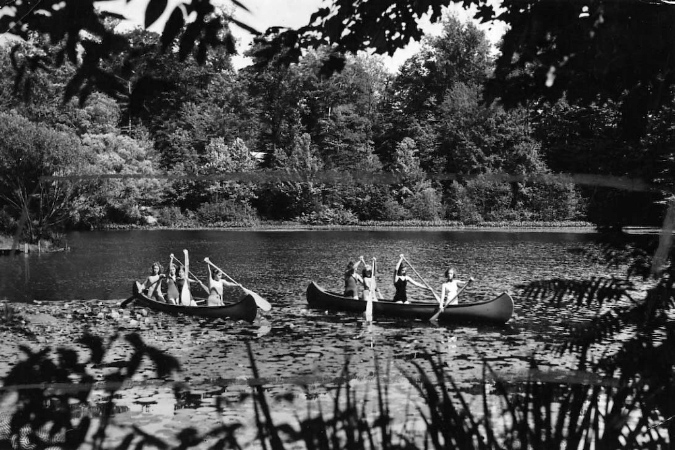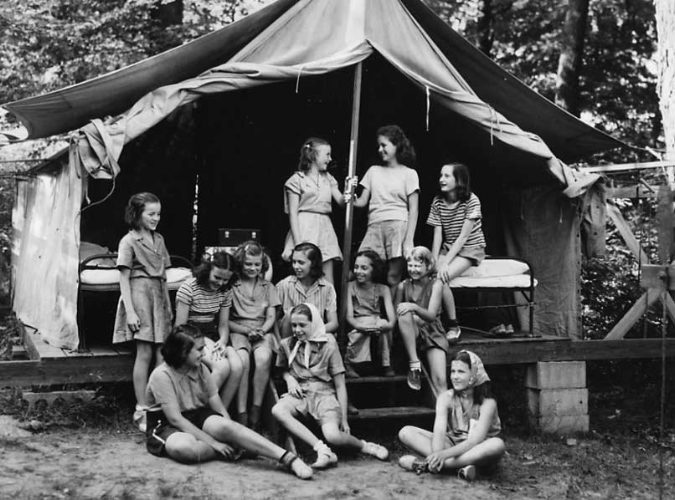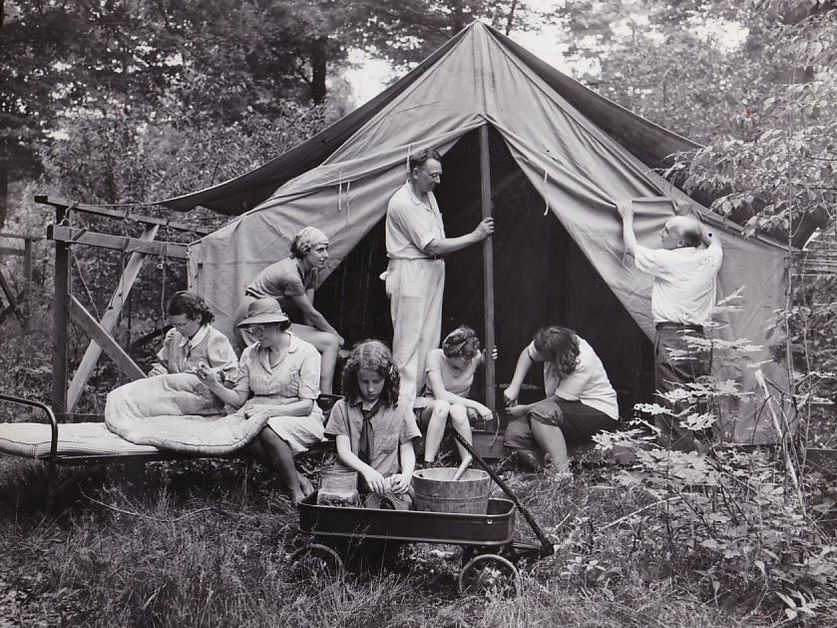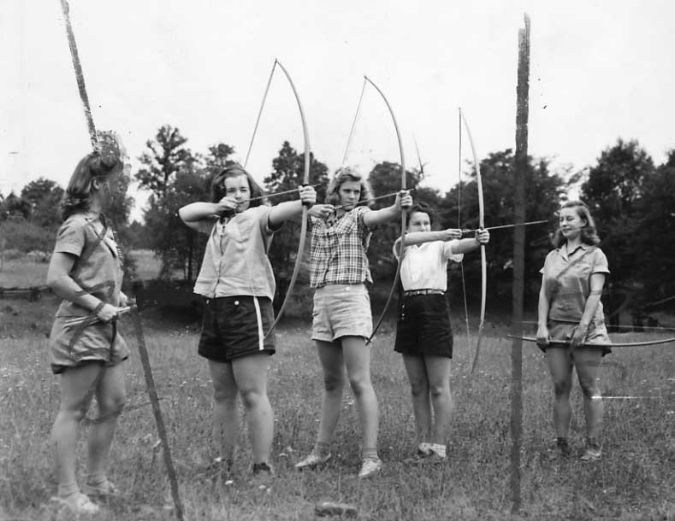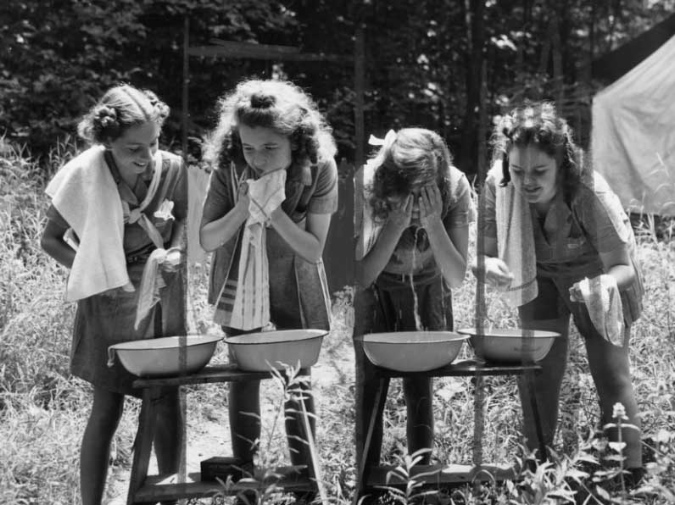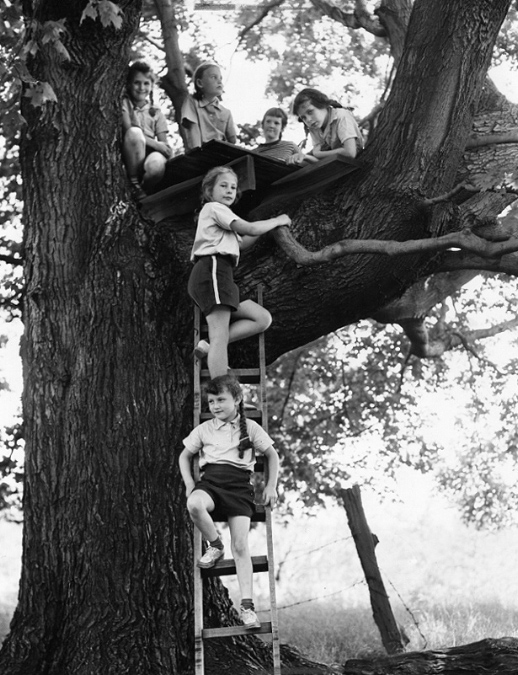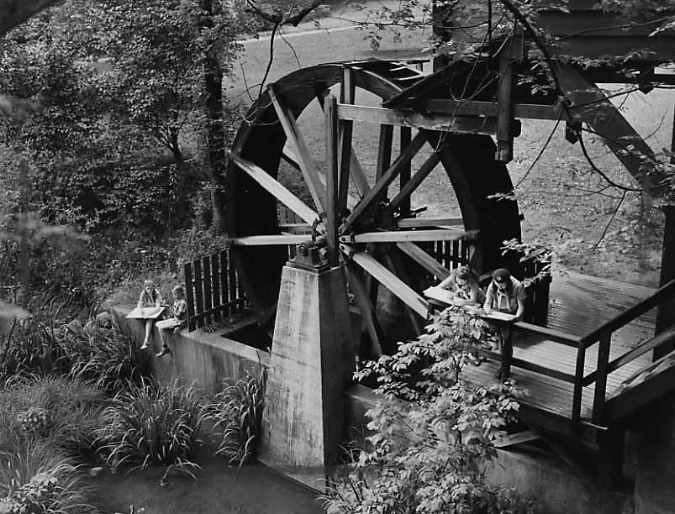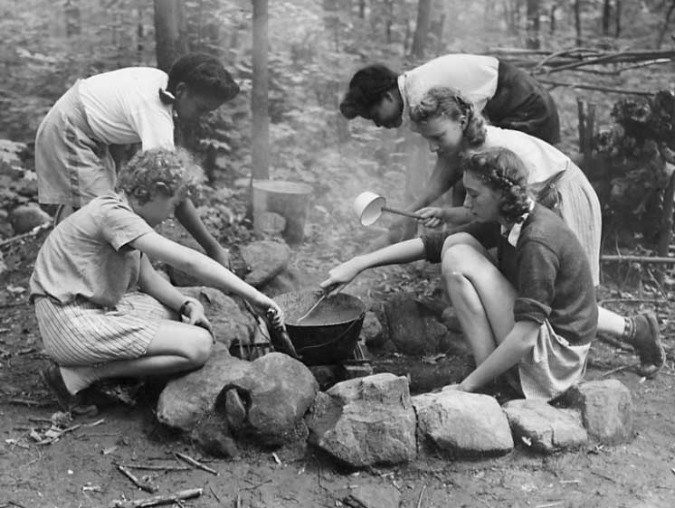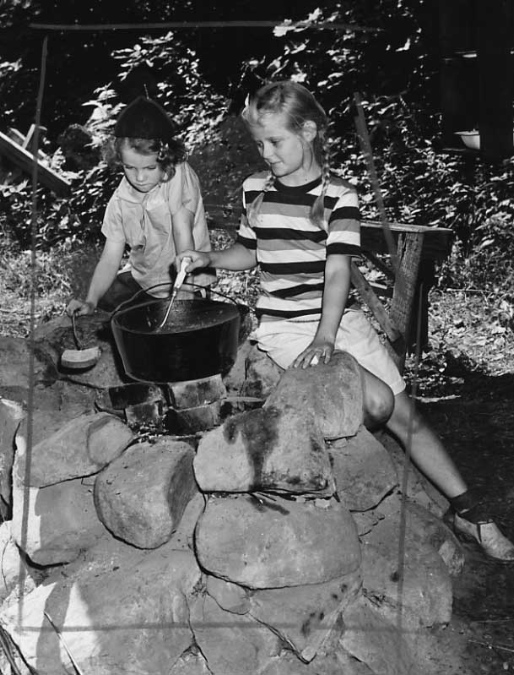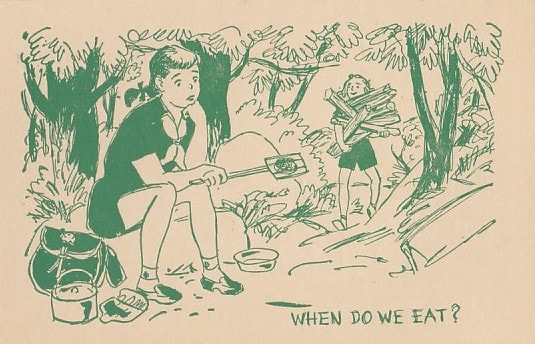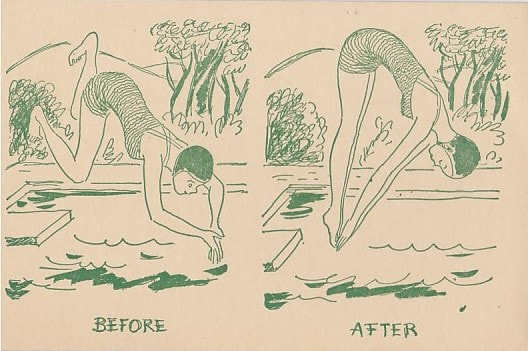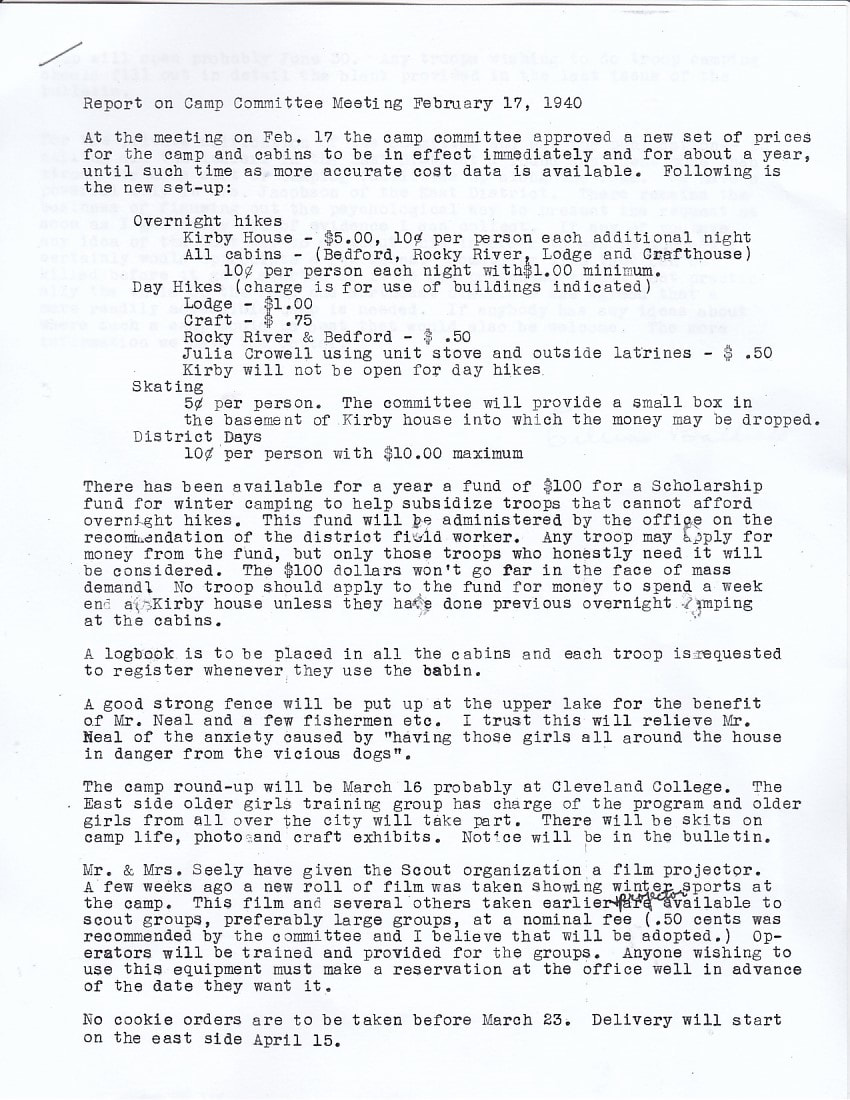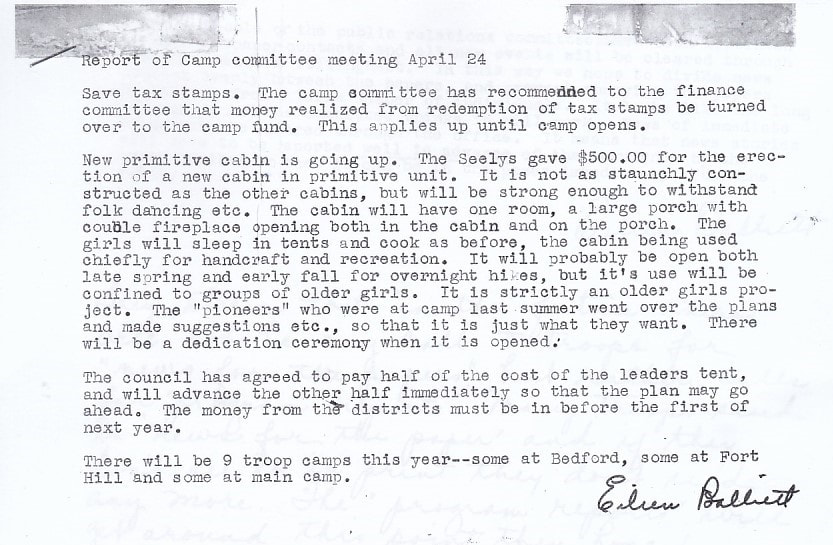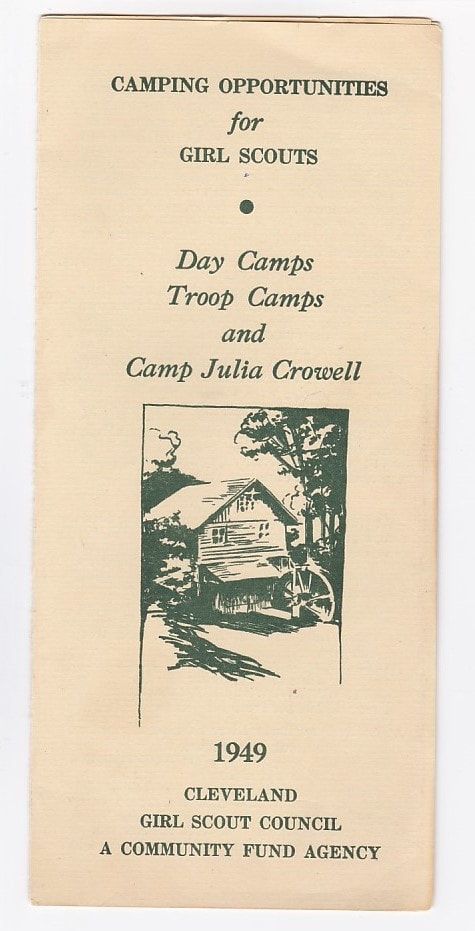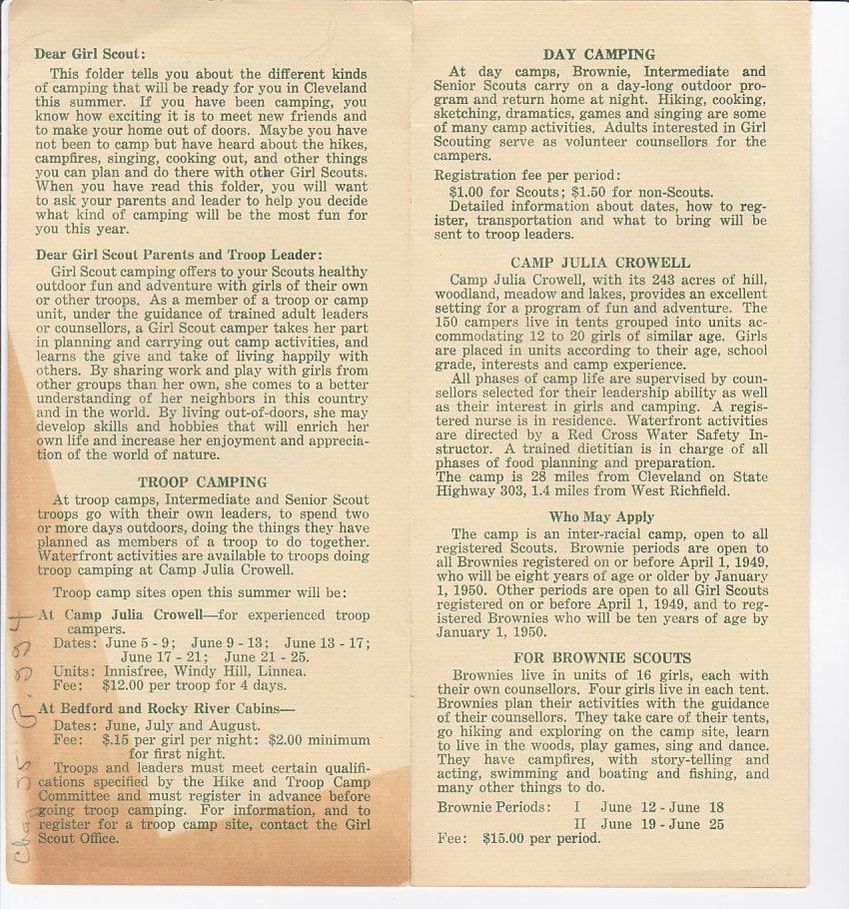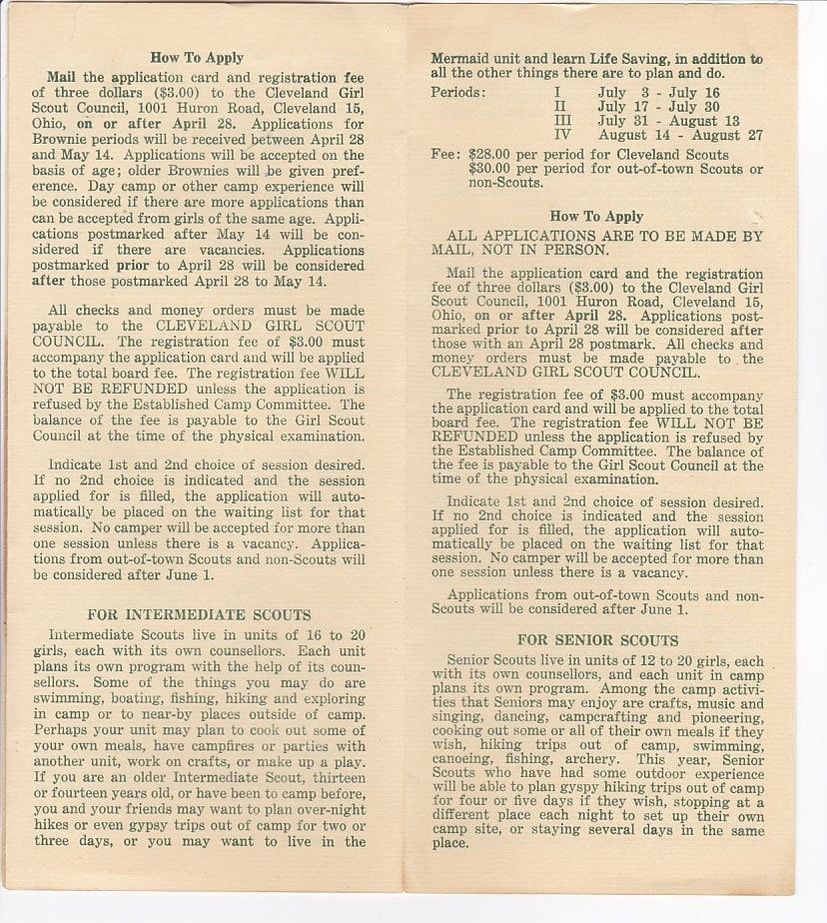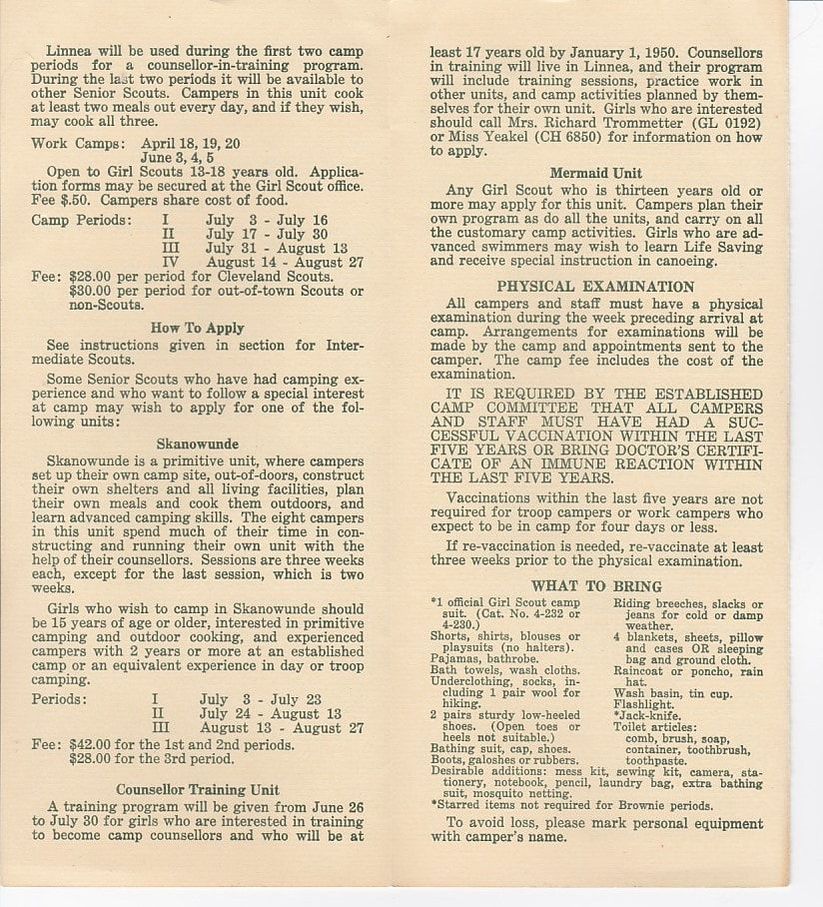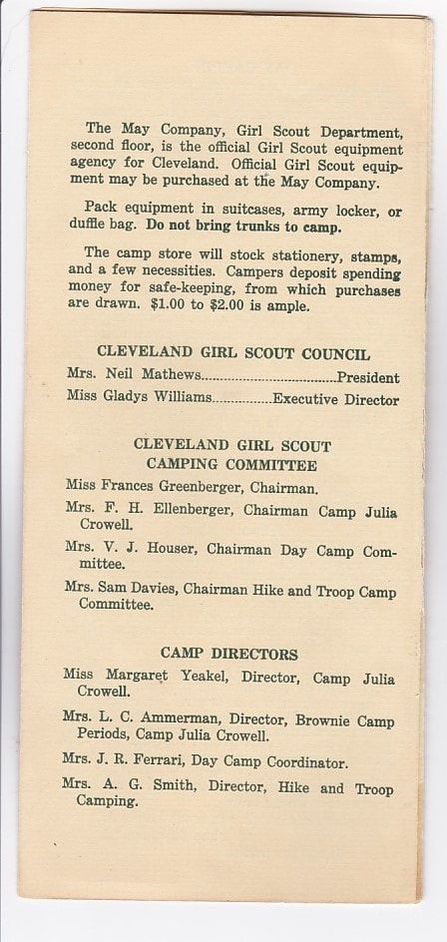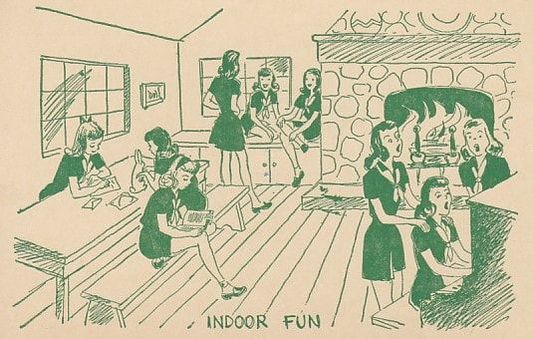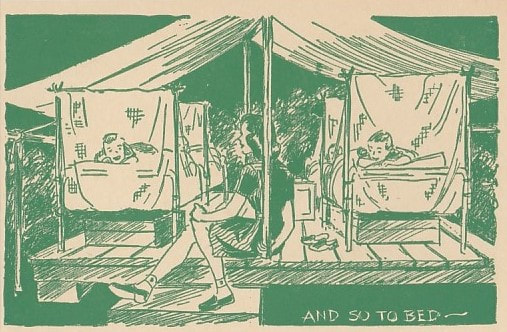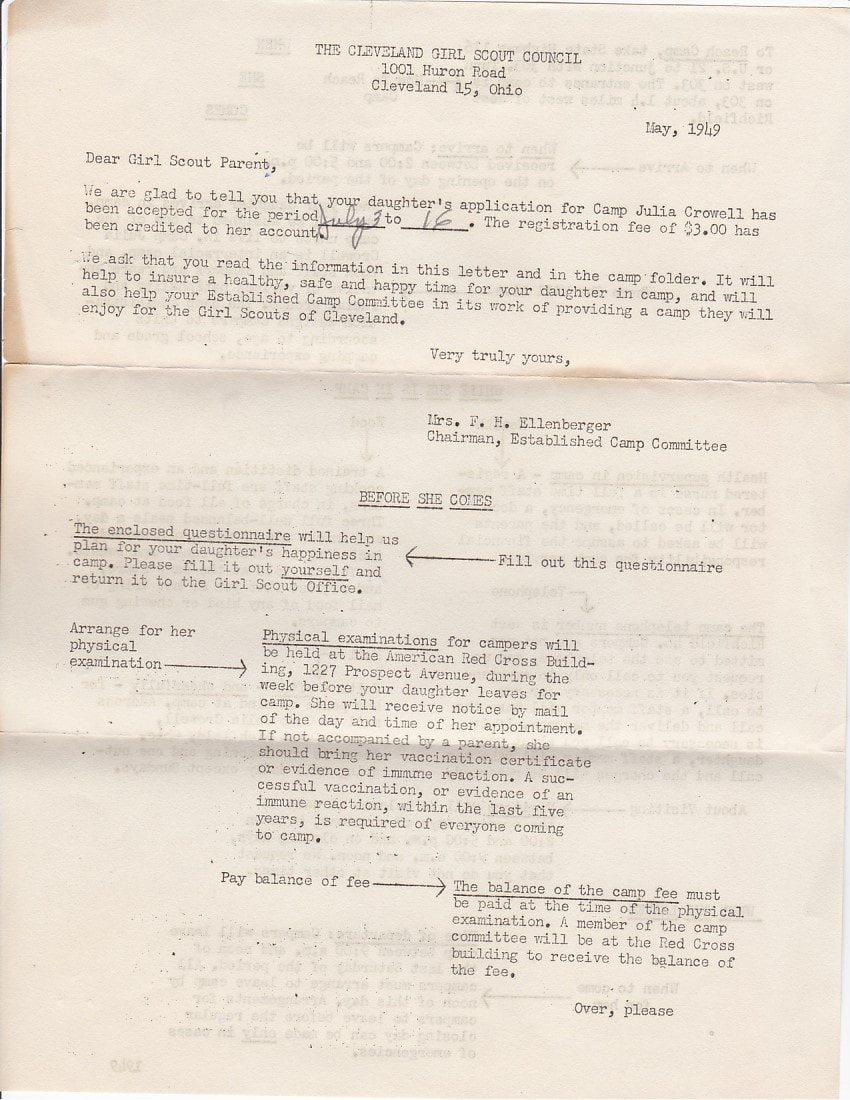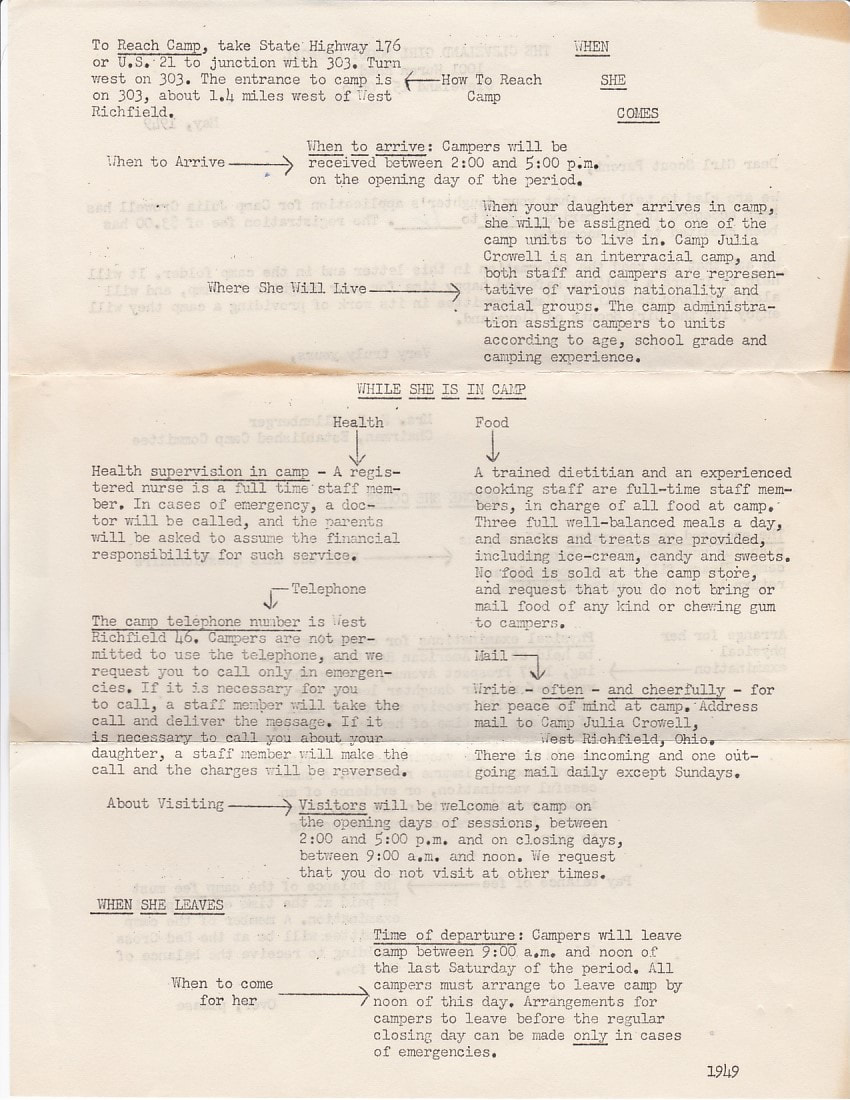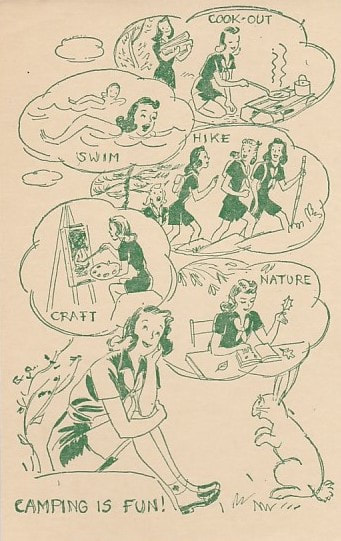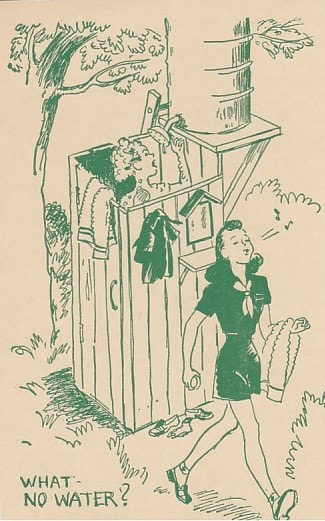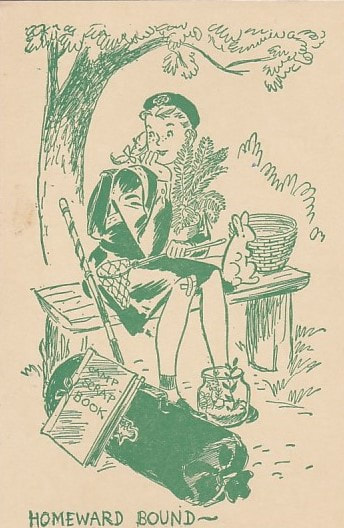GIRL SCOUTS AT CAMP - 1940s
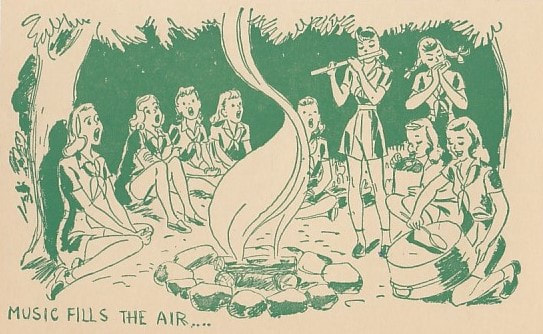
Attendance at all camps reached 200,000 girls nationwide by 1941. In Cleveland, Girl Scouts of all races, creeds, and economic backgrounds camped together. A council camp folder from 1941 listed nine separate day camps available at locations throughout the Cleveland metropolitan area. Day camping was done by troops. The registration fee was $1.00 and included all program activities except craft materials. Each troop was responsible for its own transportation (often by public transportation with each girl paying her own carfare). Girls brought a box lunch and a drinking cup…..
Troop camping was done at Old Fort Hill [ Rocky River], the Bedford Cabin, and some units at Camp Julia Crowell were set aside for troop camping. The fee was $1.00 per day per troop for use of the site, plus a fee of $ 0.50 per girl for a physical exam that was required of all participants. The average cost per girl was fifty nine and a half cents. The program included planning cook-outs, taking treasure hikes, or just exploring the woods, telling and dramatizing stories, and singing and dancing -- anything a troop might plan. Troops could camp for a week at Camp Julia Crowell for a $20.00 site fee.
Resident camping was done at Camp Julia Crowell. The individual camp fee for two weeks was $18.00 for girls registered throughout the Cleveland Council and $20.00 for out-of-town girls and non-scouts. Girls were assigned to units with girls their own age in one of eight small groups of tents with wooden floors and cots. The program varied according to the interests of the girls. Some cooking was done in the out of doors, but most meals were served in Garfield Dining Hall. The camp staff included an experienced dietitian, a registered nurse, Red Cross water safety instructors, and counselors experienced in camping and special program fields.
Under the guidance of these skilled counselors, girls learned swimming, boating, hiking, cooking in the out-of-doors, and taking part in programs around the campfire. Any Girl Scout who had been to camp had learned to walk cautiously in the woods and keep her eyes open for animal tracks, for wintergreen leaves, and for the tiny wildflowers she might have otherwise crushed with her feet. She had learned to identify constellations in the night sky and use them for finding directions. Every girl brought home from camp folk songs from many lands learned around the campfire. Perhaps the most important lesson for the girls was the magic of chores turning into fun when done by working together.
There were units with more simplified program for Brownies. Senior Scouts camped near Lake Linnea in ground tents and prepared their own meals. There was even a session for Mariner Scouts on Lake Linnea. Girls were given credit toward badges for their camp experiences. Reports were sent to troop leaders.
(from The First 75 Years- A Council History 1912-1987, Lake Erie Girl Scout Council, by Georginanna Bonds, pages 34-35)
Council activities in the late 1940’s
. . . . camping was still popular. By the end of the 1940’s the Cleveland Council alone had 1,010 girls attending day camp, 737 attending resident camp, and 1,665 attending troop camps in a single year.
. . . . To expand the facilities at our council campsite, a winterized cabin to known as Hilltop House was built at Camp Julia Crowell. The cabin was to be used for year round troop camping, for adult conferences, and for a summer rainy day shelter for resident campers. To encourage troop trip camping, the Council equipped a trailer for troop use on longer trips.
(from The First 75 Years- A Council History 1912-1987, Lake Erie Girl Scout Council, by Georginanna Bonds, pages 38-39)
Troop camping was done at Old Fort Hill [ Rocky River], the Bedford Cabin, and some units at Camp Julia Crowell were set aside for troop camping. The fee was $1.00 per day per troop for use of the site, plus a fee of $ 0.50 per girl for a physical exam that was required of all participants. The average cost per girl was fifty nine and a half cents. The program included planning cook-outs, taking treasure hikes, or just exploring the woods, telling and dramatizing stories, and singing and dancing -- anything a troop might plan. Troops could camp for a week at Camp Julia Crowell for a $20.00 site fee.
Resident camping was done at Camp Julia Crowell. The individual camp fee for two weeks was $18.00 for girls registered throughout the Cleveland Council and $20.00 for out-of-town girls and non-scouts. Girls were assigned to units with girls their own age in one of eight small groups of tents with wooden floors and cots. The program varied according to the interests of the girls. Some cooking was done in the out of doors, but most meals were served in Garfield Dining Hall. The camp staff included an experienced dietitian, a registered nurse, Red Cross water safety instructors, and counselors experienced in camping and special program fields.
Under the guidance of these skilled counselors, girls learned swimming, boating, hiking, cooking in the out-of-doors, and taking part in programs around the campfire. Any Girl Scout who had been to camp had learned to walk cautiously in the woods and keep her eyes open for animal tracks, for wintergreen leaves, and for the tiny wildflowers she might have otherwise crushed with her feet. She had learned to identify constellations in the night sky and use them for finding directions. Every girl brought home from camp folk songs from many lands learned around the campfire. Perhaps the most important lesson for the girls was the magic of chores turning into fun when done by working together.
There were units with more simplified program for Brownies. Senior Scouts camped near Lake Linnea in ground tents and prepared their own meals. There was even a session for Mariner Scouts on Lake Linnea. Girls were given credit toward badges for their camp experiences. Reports were sent to troop leaders.
(from The First 75 Years- A Council History 1912-1987, Lake Erie Girl Scout Council, by Georginanna Bonds, pages 34-35)
Council activities in the late 1940’s
. . . . camping was still popular. By the end of the 1940’s the Cleveland Council alone had 1,010 girls attending day camp, 737 attending resident camp, and 1,665 attending troop camps in a single year.
. . . . To expand the facilities at our council campsite, a winterized cabin to known as Hilltop House was built at Camp Julia Crowell. The cabin was to be used for year round troop camping, for adult conferences, and for a summer rainy day shelter for resident campers. To encourage troop trip camping, the Council equipped a trailer for troop use on longer trips.
(from The First 75 Years- A Council History 1912-1987, Lake Erie Girl Scout Council, by Georginanna Bonds, pages 38-39)
Minutes of the North East District
April 18, 1940. Main Camp . Miss Balliet. Troop Camping at Main Camp is closed. The tent unit for leaders camping out is $100.00, half of which will come from cookie sales, half to be raised by leaders. Scholarship names should be submitted now. A new dock and also a fence are being built. In connection with leader's meeting May 13 at Church of Incarnation, camp pictures will be shown. Five older girls distributed camp folders to troops.
June 1940. Main Camp. Miss Balliet reported that it is hoped that many leaders will take advantage of the Leaders' Tent, but no leader will be allowed at camp if her daughter is camping at the same time leaser wishes to. By the leaders using this tent it will give them a better chance to see just how Scouting is promoted. To date, two East District leaders have registered. West district has raised a sum of money to help pay for the leaders tent and it is hoped North East District will be able to raise by some later project.
There were 68 applications received for scholarship and not as much money available for same. Report on applications not complete.
Day Camp report 1940... The primitive group climaxed their day camping with a week's troop camping at Camp Julia Crowell with Miss Henry.
April 18, 1940. Main Camp . Miss Balliet. Troop Camping at Main Camp is closed. The tent unit for leaders camping out is $100.00, half of which will come from cookie sales, half to be raised by leaders. Scholarship names should be submitted now. A new dock and also a fence are being built. In connection with leader's meeting May 13 at Church of Incarnation, camp pictures will be shown. Five older girls distributed camp folders to troops.
June 1940. Main Camp. Miss Balliet reported that it is hoped that many leaders will take advantage of the Leaders' Tent, but no leader will be allowed at camp if her daughter is camping at the same time leaser wishes to. By the leaders using this tent it will give them a better chance to see just how Scouting is promoted. To date, two East District leaders have registered. West district has raised a sum of money to help pay for the leaders tent and it is hoped North East District will be able to raise by some later project.
There were 68 applications received for scholarship and not as much money available for same. Report on applications not complete.
Day Camp report 1940... The primitive group climaxed their day camping with a week's troop camping at Camp Julia Crowell with Miss Henry.
A final campfire ceremony was written by the girls at the end of the first summer camp session circa 1944. Contributed by Ruth Rayle
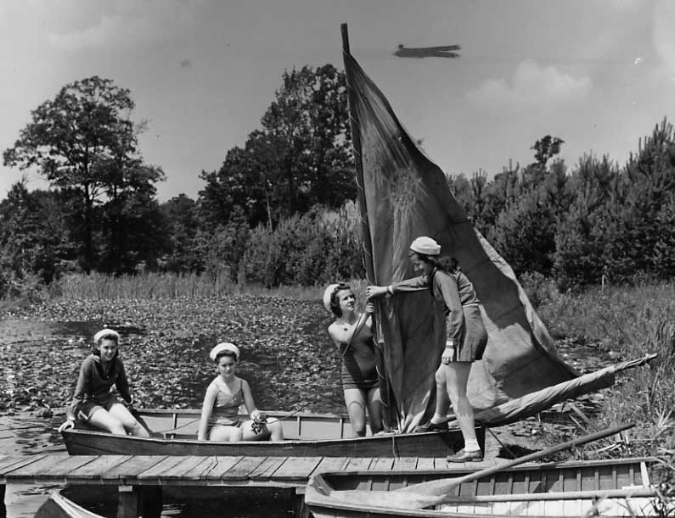 Sailing, 1942. Source: Cleveland Press Archives. Cleveland State University Special Collections LIbrary
Sailing, 1942. Source: Cleveland Press Archives. Cleveland State University Special Collections LIbrary
During the war years of the 1940's, food was rationed. Payment had to be accompanied by coupon points and families were allocated only so many points per month. Girls learned to work within the restrictions.
"So our food is rationed. What of it? There is no rationing on ingenuity. Each girl can bring a slice of bacon, a cube of cheese, or enough ground meat for hamburgers. If you use a central shopping committee one point covers a great deal.
"There is no limit to the tasty ration-free meals we can cook. Summer brings us a plentiful supply of fresh vegetables that can be used in many ways. How about a program on point-free meals?
"The girls accept rationing very sensibly, and love to bring their own 'makin's' to be added to make their meal. A piece of fruit from each girl makes a lovely bowl of fruit salad. A carrot from one, a potato from another, etc makes a vegetable plate. A tomato, a few pieces of lettuce, a green pepper, and onion, and what have you? A tossed salad! Here's to better and better meals."
- page 30 With Bundle and Stick complied by the Day Camp Committee, Cleveland Girl Scout Council. In 1950, the second edition of the this booklet notes "even tho' rationing is over, we can still profit from menu planning done during the war years.
"So our food is rationed. What of it? There is no rationing on ingenuity. Each girl can bring a slice of bacon, a cube of cheese, or enough ground meat for hamburgers. If you use a central shopping committee one point covers a great deal.
"There is no limit to the tasty ration-free meals we can cook. Summer brings us a plentiful supply of fresh vegetables that can be used in many ways. How about a program on point-free meals?
"The girls accept rationing very sensibly, and love to bring their own 'makin's' to be added to make their meal. A piece of fruit from each girl makes a lovely bowl of fruit salad. A carrot from one, a potato from another, etc makes a vegetable plate. A tomato, a few pieces of lettuce, a green pepper, and onion, and what have you? A tossed salad! Here's to better and better meals."
- page 30 With Bundle and Stick complied by the Day Camp Committee, Cleveland Girl Scout Council. In 1950, the second edition of the this booklet notes "even tho' rationing is over, we can still profit from menu planning done during the war years.

